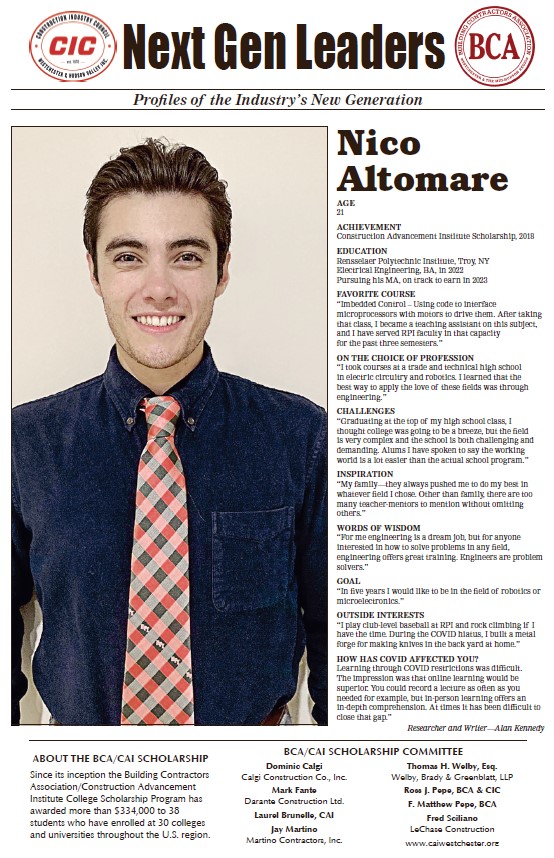News
Democracy Gets Back to Work
Leaders Hail $1.2-Trillion Infrastructure Act; Billions in New Projects Heading to Region
By JOHN JORDAN – November 19, 2021
WASHINGTON — While the ink signing into law on the $1.2-trillion “Infrastructure Investment and Jobs Act” may have dried on Nov. 15, it was the next day when President Joe Biden climbed aboard Air Force One to inspect a rickety steel bridge in Woodstock, NH that the nation would see the first example of what the federal government is doing to help write a new chapter in the history of transportation in this country.
Construction industry leaders praised the new law, described as the most significant piece of legislation in the past 50 years to deal with with the nation’s crumbling infrastructure. Industry estimates are that New York State will receive approximately $170 billion in highway, mass transit and infrastructure funding from the bi-partisan bill.
At the law’s signing ceremony at the White House, President Biden said the measure is proof that, despite the cynics, Democrats and Republicans can come together and deliver results. The legislation was supported in the House by 13 Republicans and 19 Republicans backed the measure in the Senate. This law will build back “our bridges, our water systems, our power lines, our levees better and stronger so few Americans will be flooded out of their homes or lose power in those days and weeks ahead when severe storms hit,” the President proclaimed.
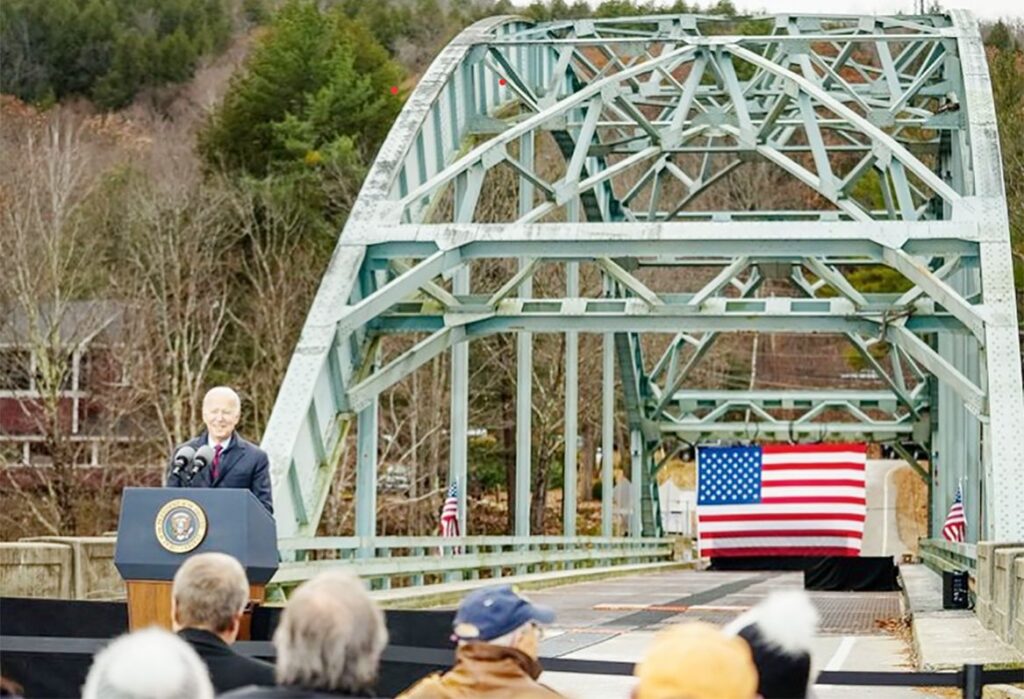
Regional Outlook
In addition to a massive increase in highway and wastewater funding levels, a host of Congressional and industry leaders believe the legislation will provide some funding for some of the Downstate region’s mega-projects, including the Gateway Tunnel project, Penn Station Access, the East River Tunnels, and the Second Ave Subway, along with needed repairs to the Brooklyn-Queens Expressway and a proposed project to cap sections of the Cross Bronx Expressway that are below street level. It is also believed that some funding could be accessed via grants for the Route 17 expansion project in Orange and Sullivan counties, as well as the I-81 improvement project in Syracuse.
“Infrastructure is always a political winner,” said John Cooney, Jr., executive director of the Construction Industry Council of Westchester & Hudson Valley, Inc. “The $1.2 trillion Bipartisan Infrastructure Legislation is a historic leap forward into the 21st century for the United States. This legislation recognizes the unparalleled legacy of the massive investments we have made in our nation’s transportation infrastructure over the past century. This infrastructure bill also allows us to tackle the enormous backlog of needs and repairs to critical facilities that protect and expand drinking water facilities and resources, that fortify our dams and make our communities safer from the ravages of catastrophic rain and wind storms and the flooding and damages they cause.”
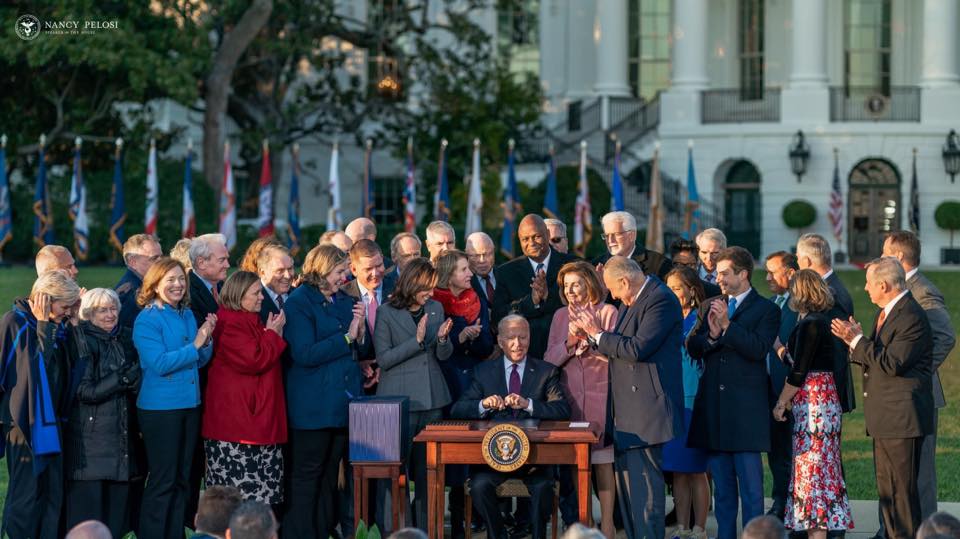
He added, “We applaud President Biden, Senate Majority Leader Chuck Schumer, House Speaker Nancy Pelosi and all our supporting members of New York State’s delegation to U.S. Congress for standing strong and pressing forward for the plan, which will benefit all Americans.” Mr. Cooney pledged CIC’s commitment to working with federal, state and regional leaders to apply for the additional funds available from the federal infrastructure bill that New York State can use to make needed improvements to public facilities and services in the Hudson Valley/Downstate region.
Other industry leaders also offered high praise for the much-needed infrastructure funding. Marc Herbst, executive director of the Long Island Contractors’ Association, said, “Today is an historic day for New York. With President Biden’s signature, the $1-trillion bi-partisan infrastructure bill will transform our state’s roads, bridges, and water infrastructure. The best part is this bill is also an investment in our people, creating good union jobs that will continue to lift our economy up off the mat. We applaud President Biden for guiding this bill through Congress and delivering on a key promise he made to the American people. Long Island and the rest of New York are shovel ready.”
The Infrastructure Investment and Jobs Act Targets:
According to the Regional Plan Association and other sources, the federal infrastructure bill will provide:
- $13.5 Billion – Fund additional highway and formula bridge aid in New York State;
- $12.5 Billion – For a competitive bridge program that states and localities will vie for;
- $1 Billion – For Reconnecting Communities Pilot Program in competitive grants for planning and projects to remove, retrofit, or mitigate existing highways that were built through neighborhoods and created a barrier to mobility and economic development;
- $7.5 Billion – For the popular RAISE (Rebuilding American Infrastructure with Sustainability and Equity) grants, formerly known as BUILD or TIGER, to fund transportation projects of national and regional significance (funded in the bill over five years);
- $3.2 Billion – For the INFRA (Infrastructure for Rebuilding America) grant program, another competitive program that funds transportation projects with a strong connection to improving freight operations;
- $3.5 Billion – For additional funding for the MTA over the next five years, and about $10 billion in total funding;
- $24 Billion – Passenger and freight rail funding as federal-state partnership set-asides for Northeast Corridor modernization and $6 billion in grants for the Northeast Corridor;
- $8 Billion – For the region’s rail network is funding for the Capital Investment Grant Program as the possible funding sources for the Gateway Program projects;
- $1 Billion – For airports, including approximately $22.6 million for Westchester County Airport and approximately $12.5 million for New York Stewart International Airport;
- $15 Billion – Set aside support within the Drinking Water State Revolving Fund to replace lead service lines across the country, including communities across New York State;
- $100 Billion – For broadband infrastructure projects nationwide.


Additional Clean Water Improvements
As part of the national program to protect and improve water infrastructure-related facilities and networks, a total of $55 billion nationwide, New York State is expected to see $2.6 billion for projects in New York State. This Act seeks to address water contaminants, including replacing lead pipes and eliminating PFAS so that New York State can ensure communities have the clean drinking water they deserve. The bill includes: billions of dollars for the Drinking Water and Clean Water State Revolving Funds which provide below-market rate loans and grants to fund water infrastructure improvements.
Climate Change Initiatives
The Act includes: $11.6 billion to the Army Corps of Engineers for flood control projects; $700 million to the Federal Emergency Management Agency for buyouts and elevations; $492 million to the National Oceanic and Atmospheric Administration to map and forecast inland flooding; and $216 million to the Bureau of Indian Affairs for adaptation and resilience measures for tribal nations, including $130 million for community relocation, the RPA stated.
In addition, the Department of Transportation will send states money to get highways out of areas prone to flooding and the Environmental Protection Agency will support communities in relocating drinking water infrastructure at risk of flooding and extreme weather. These investments will advance climate, environmental and public health goals nationally and within the lower Hudson Valley region.
Possible Funding For Route 17 Expansion
The New York State Department of Transportation is expected to release its PEL study on the expansion and make recommendations sometime this month. Preliminary cost estimates range between $500 million to more than $1 billion.
U.S. Rep. Sean Patrick Maloney (D-CD18) listed the Route 17 project at a press conference in Newburgh, NY on Nov. 8 as a highlighted project that is needed in the region. He referenced the Infrastructure Act’s $13.5 billion that will go directly to New York State’s highways and bridges, and said that revamping Route 17 through Orange County is “a much-needed project that has been stalled for too long.”
“Route 17 can receive funding through the Infrastructure Investment and Jobs Act,” a spokesman for Rep. Maloney told CONSTRUCTION NEWS. “However, the law does not directly earmark funds to specific projects. It will be up to New York State to determine how to dedicate their funds from this legislation to projects like Route 17. However, as he has throughout the legislative process drafting the Infrastructure Investment and Jobs Act, Rep. Maloney will continue to fight for funding for critical projects and priorities here in the Hudson Valley.”
Next Up: ‘Build Back Better’ Act
Finally, in what could be another major boost for the construction sector, Congress passed on Nov,. 19 by a 220-213 vote the controversial “Build Back Better” Act. The measure now goes to the Senate, where it will likely be changed. The House version includes:
- $555 Billion – For clean energy and climate investments;
- $150 Billion – For housing among a host of social funding expenditures.
- $65 Billion – To repair and preserve public housing;
- $35 Billion – To build and preserve affordable housing;
- $25 Billion – In rental assistance for those in need;
- $10 Billion – In down payment assistance for first-time homebuyers;
- $6.5 Billion – To address health hazards, including lead remediation;
- $2.45 Billion – To address fair housing and zoning reform.
This BBB wishlist, paid for with likely tax increases to uberwealthy taxpayers and a corporate rate hike, now sits at nearly $850 billion.
There was certainly lots of drama, suspense—and reward—in the months leading up to the final Congressional vote on Nov. 5 on the $1.2 trillion infrastructure package. Stay tuned for how this new one plays out!
Carpenters Union Stage Grand Re-Opening Of New Apprenticeship Center in Orange
By GEORGE DRAPEAU III
ROCK TAVERN, NY — A new comprehensive education facility to train young apprentices and advance the skills of journey-level members of Carpenters L.U. 279 officially re-opened this month in Orange County. The ribbon-cutting ceremony on Nov. 10 served as an example that imagination, when partnered with a deep organizational commitment of resources, can be the blueprint to develop a new generation of highly-skilled Carpenters.
“The best way to ensure a great future is to train for it today,” noted Bill Banfield, Assistant to the Executive Secretary-Treasurer, NASRCC. The newly renovated building, located at 52 Stone Castle Road, allows members throughout the eight counties of the Hudson Valley to develop new training and skills and acquire new knowledge.

The new North Atlantic States Carpenters Training Center took nearly two years in planning and construction to complete, at a cost of more than $3 million, reported James Hayes, assistant executive director of the North Atlantic States Carpenters Training Fund which invested in the project. Young men and women eager to pursue careers in the Building Trades now have a comprehensive training center in the region.
“We believe in ‘work local, train local’ as keys to success,” he explained, adding that the new 25,000-square-foot, two-story center is highly convenient for journey-level members seeking to upgrade skills and obtain recertification for various job requirements. Prior to the center opening, Carpentry apprenticeship training and enhanced skills-development programs required travel to one of two other Carpenters Union facilities, located on Long Island and in Albany. “An added benefit will likely be more journey-level Carpenters using the center to upgrade their skills and qualifications,” Mr. Hayes added.
The five levels of apprenticeship training, often completed in four years, instructs some 170 craftsworkers who aspire to journey-level stature.
Among the programs offered are: laser technology, 3D imaging for enhanced design and building, scaffold training, OSHA safety and fall-protection certification and recertification, advanced training in aerial lift operations, and infectious control and risk-assessment training.
The building will also provide faster and easier access for members in the Hudson Valley to acquire sophisticated training without traveling to Albany each time they need it. Union staff will occupy about a third of that, with the training program using the rest.
“This state-of-the-art facility will safely teach the highest level of skilled union tradesmen and women in a safe manner and help the hardworking Carpenters Union Local 279 complete important projects,” said Orange County Executive Steve Neuhaus. “Union carpenters are an integral part of our workforce and I thank Local 279 for the many contributions they have made in Orange County.”
Rockland County Executive Ed Day also commented, “I am grateful to the Carpenters Union for their commitment to the betterment of our region, and especially for their investment in creating opportunities for our young people. Apprenticeships provide our area youth with the ability to earn while they learn so they can secure their future in the Hudson Valley.”
“We know that making training facilities convenient for our apprentices and journey-level workers is crucial,” said Tom Fischer, Executive Director of NASCTF. “Part of our ongoing plan is to create and maintain excellent facilities and programs wherever they are needed to serve union carpenters and the contractors that rely on their skills.
Mr. Fischer noted that some 90% of a union carpenter’s training is hands-on. “You can’t do that without investing in space and equipment, so that’s what we did,” he said.
Other speakers at the event included: New York State Department of Labor Commissioner Roberta Reardon, North Atlantic States Regional Council of Carpenters Executive Secretary-Treasurer Joe Byrne and New York State Sen. James Skoufis and Sen. Mike Martucci.
The Rock Tavern facility is the latest to undergo significant expansion or upgrades in recent years. Other locations where the union has invested significantly are Manchester, N.H.; Yalesville, CT; Syracuse and Long Island’s Hauppaugue and Albany as mentioned. Plans for renovations at Warwick, R.I. were being developed when the COVID-19 pandemic hit. They are expected to be revisited soon.
$135 Million ‘Last Mile’ Improvement Job On I-95 in Westchester County Completed
ALBANY, NY — State officials announced on Nov. 1 the completion of the $135-million infrastructure improvement project on a section of the New England Thruway (I-95) in Westchester County known as the “Last Mile.”
During the past several decades, 14 miles of I-95 in the Bronx, Pelham, New Rochelle, Mamaroneck, Harrison and Rye have been reconstructed. This project, which began in 2018, focused on the final one mile stretch from Exit 22 (Port Chester – Rye – Midland Avenue) to the Connecticut state line, which serves more than 140,000 motorists every day.
“The completion of the ‘Last Mile’ project on I-95 demonstrates the Thruway Authority’s commitment to investing in infrastructure and modernizing our transportation system,” Thruway Authority Executive Director Matthew J. Driscoll said. “This stretch of I-95 is one of the busiest on the Thruway and it was long overdue for these needed upgrades to the mainline, the interchange system and local overpasses. With the completion of this project, motorists can now enjoy an improved travel experience in this area.”
ECCO III Enterprises Inc. from Yonkers, NY completed the Design-Bid-Build Best Value contract. The project included:
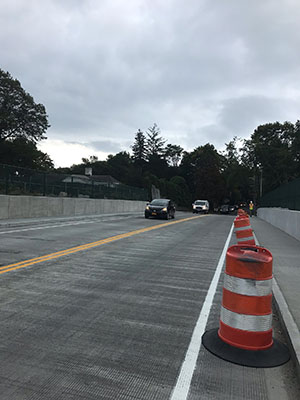
I-95 Reconstruction
The I-95 mainline (milepost 14.1 to milepost 15.0) in both directions was reconstructed along with safety upgrades such as wider shoulders, updated pavement markings and the installation of guiderails and barriers.
Ramp Upgrades
The area contains a six-ramp interchange system with the Cross Westchester Expressway (I-287) and Midland Avenue in the City of Rye and Village of Port Chester.
Several ramps were upgraded and reconfigured to improve traffic flow:
The I-287 eastbound to I-95 northbound ramp bridge was replaced and realigned; the ramp from Midland Avenue was realigned to connect directly to I-95 northbound; I-95 southbound was widened to provide a two-lane exit ramp to I-287 westbound and improvements were made to the I-95 northbound/Midland Avenue interchange.
Bridge Replacement and Rehabilitation
The Grace Church Street bridge over I-95 (milepost 14.46) was replaced and opened in September 2020
The Boston Post Road bridge (milepost 13.71), Purchase Street bridge (milepost 13.48), the Blind Brook culvert bridge (milepost 13.34) and the Byram River bridge (milepost 14.93) were rehabilitated.
Senator Shelley B. Mayer said, “An incredible amount of planning went into ensuring the construction on this critical, high volume stretch of the Thruway addressed safety and neighborhood concerns. I applaud the Thruway Authority for working with neighbors and municipal officials to make this project as least disruptive as possible, and I am confident they will continue to engage the community moving forward. Congratulations on the completion of the ‘Last Mile.’”
Assemblymember Steve Otis added, “Congratulations to the Thruway Authority, contractors and workers who have reached a major milestone towards completion of the Last Mile project. This project is one of the largest reconstruction projects in the history of the Authority. It was planned for decades and was needed to address safety and neighborhood concerns.”
He added, “A project of this scale involved disruption to communities, neighborhoods and motorists but from the local perspective the Thruway Authority made adjustments in design and in the construction schedule to address issues raised along the way and continues to work with us on issues that arise. I appreciate the authority’s responsiveness in working with neighbors and municipal officials which I have seen firsthand here and across the state.”
Call for Downstate Casino Licenses Grows Louder
Business, Organized Labor, Elected Officials Rally for State Legislation
YONKERS, NY — “A Sure Bet for New York’s Future” alliance teamed with state and local elected officials and community partners in a spirited rally outside the Empire City Casino by MGM Resorts building here on Nov. 17 to voice overwhelming community support for legislation to permit full-scale commercial casino licenses here in Westchester.
Pointing to the thousands of jobs such a project would create in Yonkers, Mount Vernon and the Bronx, Assemblymember Gary Pretlow, chair of the Racing and Wagering Committee, called on Gov. Kathy Hochul to support his legislation to accelerate the downstate casino licensing process.
“We in this part of the state want this to happen, and we want it to happen now. This helps the Bronx, Westchester, Rockland County, and the State of New York. That’s what this is all about helping the State of New York,” Rep. Pretlow said.
New York State Gaming Commission recently issued a Request for
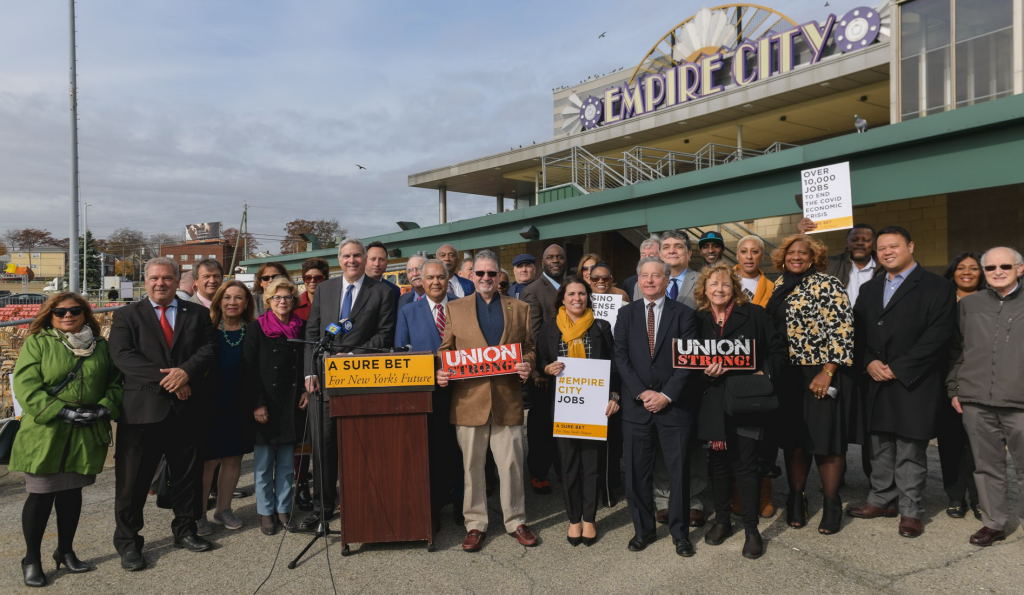
Information from interested parties for either developing or operating three downstate New York casinos in the New York metro region.
The issuance of the RFI on Oct. 20 followed the release of a report detailing the impacts of downstate casino gaming and mobile sports betting by Spectrum Gaming Group released in January 2021 that found downstate counties show the greatest potential for growth in Gross Gaming Revenue, ranging from $970 million to $4.49 billion for New York City, and $606 million to $1.13 billion for Long Island. The potential of the New York City market could be captured by the addition of new gaming facilities, the report stated.
The Gaming Commission has set a deadline for the submission of questions concerning the RFI for Nov. 10, 2021 and for a submission to the RFI by Dec. 10, 2021. The New York State Gaming Commission per state statute has to prepare and distribute a report on the RFI to the governor and the State Legislature no later than six months from the Dec. 10, 2021 deadline. The statute was passed by the State Legislature and signed by then Gov. Andrew Cuomo in April 2021.
If the process does move forward, it could be assumed that a Request for Proposals could be issued in mid-2022 and an award sometime thereafter. It should be noted that the state’s gaming law bans the award of downstate casino licenses until 2023. The measure was intended to allow the upstate casinos to establish a client base before they faced competition from downstate facilities.
“From a business standpoint, from a local government standpoint, this is a no brainer,” said Westchester County Executive George Latimer, adding, “You have here already the infrastructure for the most successful casino you could imagine.”
Yonkers Mayor Mike Spano said, “Enough is enough. We don’t need to wait. We know that this will bring in hundreds of millions of dollars in revenue and thousands of jobs to this region.”
“This is not the circus that comes to town and picks up and leaves,” noted Mount Vernon Mayor Shawyn Patterson-Howard, adding “This is ten thousand jobs here to stay.”
“I can’t think of a project more deserving of our collective attention than getting full gaming right now, this year for Yonkers and for downstate,” said State Sen. Shelley Mayer. “We in the Senate majority under the leadership of Andrea Stewart-Cousins are totally committed to getting this done this year, no question, no excuses, no delay.”
“This is a renaissance moment for not only my city of Yonkers, but all of Westchester and the Bronx, and really the region,” said Assemblymember Nader Sayegh. “Let’s keep the revenue right here in New York State.”
“We need to come back bigger, stronger, better, and that’s what this investment can do,” stated Assemblymember Nathalia Fernandez, a member of the Bronx delegation. “I really hope the Governor is on board, because if not, she’s going to hear from all of us, especially in the Bronx.”
Community groups also showed their support for the project, which they say will have far-reaching benefits to the local community.
“Returning parents back to work is one of the city’s highest goals so we don’t have to rely on staying home,” said Henry Wilson, alliance co-chair and executive director of Youth Community Outreach Program. “I strongly support this effort, the board of directors of the Mount Vernon YCOP strongly supports this effort, and many of my colleagues and all the friends and parents support this effort.”
Local leaders also underscored the importance of the long-term investment that a full-scale commercial casino license at Empire City represents.
“This could be a huge, game-changing incubator for workforce development like we’ve never seen before,” said John Ravitz, Alliance co-chair and Vice President and COO of the Business Council of Westchester. Citing local support for the full casino license, Ravitz noted “Westchester, the Bronx, and all of the downstate region are urging Albany to work quickly. Downstate can’t wait.”
Highlighting the broader economic effects of a full-scale license for Empire City, Lisa Sorin, Alliance co-chair and President of the Bronx Chamber of Commerce said, “We keep talking about the jobs, which are so critical, but we’re also looking at businesses that will be supported by this; minority-owned businesses, small mom and pop shops, construction work, everything that’s needed to build something like this.”
“Ten thousand jobs in this economy is definitely a sure bet to help the Bronx’s economy, Westchester’s economy, and the state’s economy,” stated Marlene Citron, Alliance co-chair and President of Bronx Overall Economic Development Corp. Emphasizing the urgent need for the casino licensing process to move forward, she added, “There are a lot of jobs that were lost during COVID that are not coming back. So, we need these jobs, and we need to ensure that this casino be brought here so that all of us can win.”
The Alliance includes more than 70 business, labor, nonprofit and community organizations from Westchester and the Bronx who support the creation of thousands of new, family-sustaining union jobs for local families.
Attendees stressed the importance of Albany prioritizing meaningful relief and sustainable job growth for a region severely impacted by the COVID-19 recession. Alliance members repeatedly highlighted the overwhelming community support for Empire City to be able to apply for and receive a full gaming license.
The press conference featured remarks from Yonkers Mayor Mike Spano, Westchester County Executive George Latimer, NYS Senator Shelley Mayer, Assembly Members Nader Sayegh, J. Gary Pretlow, Nathalia Fernandez, and Steve Otis, Mount Vernon Mayor Shawyn Patterson Howard, Yonkers City Council Members John Rubbo, Mike Breen and Tasha Diaz, along with the founding co-chairs of “A Sure Bet for New York’s Future”, co-chairs John Ravitz, Vice President and COO of the Business Council of Westchester; Thomas Carey, President of Westchester Putnam Central Labor Body; Marlene Cintron, President of Bronx Overall Economic Development Corp; Lisa Sorin, President of The New Bronx Chamber of Commerce; and Henry Wilson, Executive Director of Y-COP.
Also in attendance were representatives for NYS Senate Leader Andrea Stewart Cousins and Yonkers City Council Member Shanae Williams.
Members of the Alliance also attended to show their support, including John Cooney, Jr, Executive Director, Construction Industry Council of Westchester and Hudson Valley Inc.; Carlos Laboy, COO of the Municipal Housing Authority of Yonkers; Henry Djonbalaj, President, McLean Avenue Merchant Association; Carmen Goldberg, Advisor, 100 Hispanic Women of Westchester; Millie Becker, President, Skyqueen Enterprises; Kenneth Plummer, President, Kensworth Consulting; Richard McSpeddon, Vice President, LOCAL 3 IBEW / Westchester Central Labor Body; Florence McCue, Yonkers Federation of Teachers; Stacey Thompkins, President, Tompkins Excavating; Dwayne Norris, Co-founder & COO, Soulful Synergy; Douglas Singer, Managing Member, Singer Law PLLC; Olga Luz Tirado, Executive Director, Bronx Tourism Council, and Jodie Reaver of SWAC-PAC.
The Alliance currently has more than 70 members, and it continues to grow.
A Sure Bet for New York’s Future is an Alliance of businesses, community organizations, labor groups, and other local groups who are calling on Albany to introduce a process and timeline to quickly award downstate full-gaming commercial casino licenses to create thousands of new jobs New Yorkers need, create billions in economic impact, and help revitalize our communities.
Attorney's Column
Appellate Court to Contractor: Ignore Cure Periods at Your Own Peril
By THOMAS H. WELBY, P.E., ESQ. and GREGORY J. SPAUN, ESQ.

It is well known that in business, including the construction business, the applicable contract governs the relationship between the parties. As the subject of negotiation, its specific terms should be familiar to all parties. Unfortunately, during the bustle of the project, some contractual provisions, including notice provisions and right to cure provisions, fall by the wayside. While the majority of the time these missed provisions end up being inconsequential, because the parties make their way past the issues and deal with them at the end of the job, an appellate court in East Empire Construction, Inc. v Borough Construction Group LLC, reminds us of the importance of complying with these provisions so that any subsequent actions, such as a termination, will be valid.
Background
In 2015, Borough Construction Group, a general contractor, entered into a subcontract with East Empire Construction whereby East Empire was to perform the steel scope of work for the construction of a building in Columbus Circle in Manhattan. The relevant contract, which was an AIA A401/201 form of contract, contained a provision permitting Borough to undertake to correct East Empire’s defective work if East Empire failed to do so itself within five days of receiving notice of such defective work. Another provision of the contract required Borough to provide East Empire with a 10-day period within which to cure any defect as a condition precedent to termination.
In May of 2016, Borough sent East Empire a notice of termination, stating that the subcontract would be terminated three days from the date of the letter, claiming that East Empire was in default by “failing to provide sufficient manpower [and] failing to meet the schedule, safety regulations and qualified workmanship” for the project. The parties discussed these issues and, after negotiations, Borough withdrew its termination letter. One week later, Borough sent East Empire an identical notice of termination, and subsequently retained a new steel contractor to complete East Empire’s scope of work.
In November 2016, East Empire sued Borough for breach of contract, alleging that Borough breached the contract by improperly terminating East Empire’s subcontract, and seeking the monies for which it had invoiced up until the termination. Borough denied the allegations in the complaint, and asserted East Empire’s claimed breaches of the subcontract as a defense to payment. East Empire moved for summary judgment in its favor on its breach of contract claim, and dismissing Borough’s affirmative defense, on the grounds that Borough denied it of its contractual opportunity to cure the claimed defects. In opposition, Borough argued that East Empire’s acts of default were persistent and incurable.
Decision
The motion court granted East Empire’s motion, and found that by failing to give East Empire the opportunity to cure provided for in the subcontract, Borough’s second attempt at termination was improper and, itself, constituted a breach of that contract. The appellate court affirmed, addressing not only the clear lack of the contractually required cure period, but also the limited exceptions to this requirement. The appellate court discussed that while such a notice to cure need not be given in at least four instances: where the terminated party repudiates its performance; where the terminated party abandons the project; where the breach is impossible to cure; or where the breach is so substantial that it undermines the entire contractual relationship such that it cannot be cured, the exceptions are of very limited scope. None applied here. In doing so, the appellate court cited well-settled law in holding that the defaults complained of, mere faulty steelwork and failing to meet the schedule, was “the very situation to which the cure provision was intended to apply.”
Comment
Notice and opportunity to cure provisions, like other contractual provisions, must—absent extraordinary circumstances—be strictly complied with. Typically, arguments that extraordinary circumstances apply are made not when there are such extraordinary circumstances, but when the notice and cure provisions are overlooked (or, in a haste to remove a contractor from a project, are simply not complied with).
East Empire highlights how a subcontractor in default was able to completely turn the tables on the general contractor and not only avoid the consequences of its own default (in this case being back-charged for the excess cost incurred by the general contractor to complete its work), but also have an affirmative recovery and get paid for its (claimed defective) work. While the reflexive statement to a contractor in default is to “get off of my jobsite,” contractors would be well advised to review their contracts to see if there are notice and cure provisions, and then strictly comply with them. Surely the offense at having the contractor around for an extra few days while he tries to remedy a default is not as grievous as having to not only forego a back-charge for excess completion costs, but also actually writing that contractor a check for work you believe is defective. If you have any questions as to whether such an exception applies, experienced construction counsel can help.
About the author: Thomas H. Welby, an attorney and licensed professional engineer, is General Counsel to the Construction Industry Council of Westchester and the Hudson Valley, and is the Founder of, and Senior Counsel to the law firm of Welby, Brady & Greenblatt, LLP, with offices located throughout the Tri-State/Greater Metropolitan Region. Gregory J. Spaun, General Counsel to the Queens and Bronx Building Association, and an attorney and a partner with the firm, co-authors this series with Mr. Welby.
Regional Bid Alert - November 2021
NYSDOT – Region 8
Bid Letting Date: Dec. 2, 2021
New York State Department of Transportation
Contract Management
50 Wolf Road, 1st Floor, Suite 1CM
Albany, NY 12232
Contract# D264659
PIN# 803048
FA Proj.# Z0E1-8030-483
Project Description: Rockland Co., Paving Route 59 from
Route 303 to Route 9W and sidewalk improvements at West Broadway.
Bid Deposit: 5% of Bid (~ $125,000.00)
Goals: DBE: 10.00%
Bid Letting Date: Dec. 2, 2021
New York State Department of Transportation
Contract Management
50 Wolf Road, 1st Floor, Suite 1CM
Albany, NY 12232
Contract# D264593
PIN# 810632
FA Proj.# Z0E1-8106-323
Project Description: Westchester Co., ramp reconstruction I-287 EB to Saw-
Mill River Parkway NB.
Bid Deposit: 5% of Bid (~ $375,000.00)
Goals: DBE: 9.00%
Bid Letting Date: Dec. 16, 2021
New York State Department of Transportation
Contract Management
50 Wolf Road, 1st Floor, Suite 1CM
Albany, NY 12232
Contract# D264523
PIN# 876232
Project Description: Orange, Rockland Cos., culvert rehabilitation and
replacement. – Lower Rd (CR12) over tributary to Wallkill River and
Wesley Chapel Rd over Willow Tree Brook. – 2018 BRIDGE NY ROUND 2 –
CULVERT BUNDLE 5.
Bid Deposit: 5% of Bid (~ $75,000.00)
Goals: MBE: 9.00%, WBE: 13.00%, SDVOB: 6.00%
NYSDOT – Region 10
Bid Letting Date: Dec. 2, 2021
New York State Department of Transportation
Contract Management
50 Wolf Road, 1st Floor, Suite 1CM
Albany, NY 12232
Contract# D264592
PIN# 0DPM21
FA Proj.# Z0E1-0DPM-213
Project Description: Nassau, Suffolk Cos., durable pavement markings
project, various locations.
Bid Deposit: 5% of Bid (~ $375,000.00)
Goals: DBE: 10.00%
Bid Letting Date: Dec. 2, 2021
New York State Department of Transportation
Contract Management
50 Wolf Road, 1st Floor, Suite 1CM
Albany, NY 12232
Contract# D264634
PIN# 081026
Project Description: Nassau, Suffolk Cos., guide rail rehabilitation, replace
guiderail sections at various locations.
Bid Deposit: 5% of Bid (~ $375,000.00)
Goals: MBE: 9.00%, WBE: 13.00%, SDVOB: 6.00%
Bid Letting Date: Dec. 2, 2021
New York State Department of Transportation
Contract Management
50 Wolf Road, 1st Floor, Suite 1CM
Albany, NY 12232
Contract# D264638
PIN# 053480
Project Description: Nassau, Suffolk Cos., resurfacing on Southern State
Parkway in the Towns of Babylon, Hempstead and Oyster Bay.
Bid Deposit: 5% of Bid (~ $1,500,000.00)
Goals: DBE: 10.00%
Bid Letting Date: Dec. 2, 2021
New York State Department of Transportation
Contract Management
50 Wolf Road, 1st Floor, Suite 1CM
Albany, NY 12232
Contract# D264683
PIN# DRC121
FA Proj.# Z24E-DRC1-214
Project Description:
Bronx, Dutchess, Kings, Nassau, New York, Orange, Putnam, Queens,
Richmond, Rockland, Suffolk, Westchester Cos., debris removal throughout
Downstate New York.
Bid Deposit: 5% of Bid (~ $375,000.00)
Goals: DBE: 10.00%
Westchester County DPW
Bid Due Date: Dec. 1, 2021
Contract: 15-517 ($100.)
Title: Outfall Jetty Rehabilitation, Mamaroneck Wastewater
Treatment Plant, Mamaroneck, NY.
Description: The work under this contract consists of
providing all necessary labor, material and equipment
required to construct a new steel sheet pile bulkhead
around the existing effluent Outfall Jetty located within
the Village of Mamaroneck’s Harbor Island Park. The new
steel sheet pile bulkhead, using marine grade steel, will be
constructed to the same finished elevation as the existing
steel bulkhead and approximately two feet to the waterside
of the existing steel bulkhead. Some portions of the new
bulkhead will be constructed using stone revetment to the
waterside of the existing bulkhead in areas where the new
steel sheet piling is not being installed. A new concrete pile
cap will be constructed on top of the new steel sheet piling
which will also serve as a foundation for a new perimeter
fence. In addition, previous pavement walkways, decorative
lighting, benches, fencing and grass areas will be
installed on the surface area of the rehabilitated jetty.
Bid Estimate Range: $5.4 million to $6.0 million.
MANDATORY PRE-BID INSPECTION: Scheduled at 10:00
a.m. on Nov. 3, 2021; meeting at Lobby of Mamaroneck
Wastewater Treatment Plant, 119 West Boston Post Road,
Mamaroneck, NY 10543. MANDATORY attendance is
required. Bids will be rejected from Contractors not in
attendance at this meeting, or those who fail to sign the
attendance sheet.
Contact: John Coelho, 914-995-5144.
Bid Due Date: Dec. 1, 2021
Contract: 18-515 ($100.)
Title: Roof Replacement Program, Mamaroneck Water
Resource Recovery Facility, Peekskill Water Resource
Recovery Facility, Mamaroneck and Peekskill, NY.
Description: The work under this contract consists of
providing all necessary labor, material and equipment
required for the full roofing system replacement and
select structural modifications to the following roofs: The
Primary Building including influent and effluent wings at the
Mamaroneck Water Resource Recovery Facility (WRRF) in
the Mamaroneck Sanitary Sewer District (SSD) and the Administration
Building and Blower Building at the Peekskill
WRRF in the Peekskill SSD. Work involved will address
the replacement of all building roofing systems, resetting
or replacement of coping stones, caulking of vertical joints,
installation of safety railings, walking pads, brick repointing,
repair or replacement of expansion joints and other related
work as necessary at both facilities.
Bid Estimate Range: $2.5 million to $3.0 million.
MANDATORY PRE-BID INSPECTION: Held Oct. 28, 2021.
MANDATORY attendance was required. Bids will be rejected
from Contractors not in attendance at this meeting,
or those who failed to sign the attendance sheet.
Contact: John Coelho, 914-995-5144.
Bid Due Date: Dec. 1, 2021
Contract: 19-531 ($100.)
Title: Infrastructure Upgrades, Labs and Research, Valhalla
Campus, Valhalla, NY.
Description: The work under this contract consists of providing
all necessary labor, material and equipment required
for exterior renovations including wall panel replacement,
improvements at the loading dock including sidewalk
replacement as well as interior renovations including
reception atriums, staff lounge, finishes and various related
work. Note: The Contractor is directed to the Special Notice
regarding Project Labor Agreement (PLA).
Bid Estimate Range: $800,000 to $1.0 million.
MANDATORY PRE-BID INSPECTION: Scheduled at
10:00 a.m., Nov. 10, 2021; meeting at Labs and Research,
10 Dana Road, Valhalla, NY. MANDATORY attendance
is required. Bids will be rejected from Contractors not in
attendance at this meeting, or those who fail to sign the
attendance sheet.
Contact: Adam Kaplinski, 914-995-3991.
Bid Due Date: Dec. 1, 2021
Contract: 21-516 ($100.)
Title: Tarrytown Lighthouse Restoration, Kingsland Point
Park, Village of Sleepy Hollow, NY.
Description: The work under this contract consists of providing
all necessary labor, material and equipment required
to repair caissons and the lighthouse tower exterior as well
as replacement of windows and doors, repair of floors,
upgrade of electrical systems, paving. Note: The Contractor
is directed to the Special Notice regarding Project Labor
Agreement (PLA).
Bid Estimate Range: $2.0 million to $2.3 million.
MANDATORY PRE-BID INSPECTION: Scheduled at 10:00
a.m. on Nov. 9, 2021; meeting at Kingsland Point Park –
Parking Lot. MANDATORY attendance is required. Bids
will be rejected from Contractors not in attendance at this
meeting, or those who fail to sign the attendance sheet.
Contact: Adam Kaplinski, 914-995-3991.
Bid Due Date: Dec. 15, 2021
Contract: 15-550 ($100.)
Title: Woodlands Lake Dam Rehabilitation, V.E. Macy Park,
Irvington, NY.
Description: The work under this contract consists of providing
all necessary labor, material and equipment required
to modify the existing stone masonry dam spillway, replace
the existing bridge with a pre-engineered bridge and
relocate utilities supported on the bridge, replace handrails,
modify the lakebed to create a low-flow channel and install
new plantings.
Bid Estimate Range: $4.0 million to $4.5 million.
MANDATORY PRE-BID INSPECTION: Scheduled at 10:00
a.m. on Nov. 16, 2021; meeting at project site.
Contact: Esther Rivas, 914-995-5584.
NYS Dormitory Authority
Bid Letting Date: Dec. 7, 2021
Title: City University of New York, New York City College
of Technology, Pearl Building Façade Replacement and
Associated Asbestos Abatement
Contract: CR17 General Construction
Project Number 3562209999
Sealed bids for the above Work located at New York City
College of Technology, 259 Adams Street, Brooklyn, NY
11201 will be received by DASNY at its office located
at 515 Broadway, Albany, NY 12207. Each bid must be
identified, on the outside of the envelope, with the name
and address of the bidder and designated a bid for the
Project titled above. When a sealed bid is placed inside
another delivery jacket, the bid delivery jacket must be
clearly marked on the outside “BID ENCLOSED” and “ATTENTION:
CONSTRUCTION CONTRACTS – DOMINICK
DONADIO.” DASNY will not be responsible for receipt of
bids which do not comply with these instructions.
The Dormitory Authority of the State of New York (“DASNY”)
has determined that its interest in obtaining the best
work at the lowest possible price, preventing favoritism,
fraud and corruption, and other considerations such as the
impact of delay, the possibility of cost savings advantages
and any local history of labor unrest are best met by use
of a Project Labor Agreement (“PLA”) on this Project. The
successful low bidder, as a condition of being awarded this
Contract, will be required to execute the PLA described in
the Information for Bidders and included in the Contract
Documents. See Section 18.0 of the Information for Bidders
of the Contract Documents for additional information.
All subcontractors of every tier will be required to agree to
be bound by the PLA.
All individuals who plan to attend pre-bid meetings or
bid openings in person will be required to complete and
present a DASNY Visitor Covid-19 Screening Questionnaire,
present government-issued picture identification to
building security officials and obtain a visitors pass prior
to attending the bid opening. The questionnaire and all
instructions are located after Section 19.0 of the Information
for Bidders.
Individuals and entities submitting bids in person or by
private delivery services should allow sufficient time for
processing through building security to assure that bids are
received prior to the deadline for submitting bids.
All bid openings will be made available for viewing live via
Zoom at www.zoom.us. To enter the meeting, select “Join
a Meeting” then enter Meeting Id 353 471 6521, Password
- Individuals are strongly encouraged to utilize
this public viewing option as an alternative to in person
attendance at bid openings.
Only those bids in the hands of DASNY, available to be
read at 2:00 PM local time on December 7, 2021 will be
considered. Bids shall be publicly opened and read aloud.
Bid results can be viewed at DASNY’s website; http://www.
dasny.org.
In accordance with State Finance Law § 139-j and § 139-k,
this solicitation includes and imposes certain restrictions
on communications between DASNY personnel and
a prospective bidder during the procurement process.
Designated staff for this solicitation is: Michael Costache,
Sr. Project Manager, 186 Jay Street, Brooklyn, NY 11201,
917-299-2863, mcostache@dasny.org (the Owner’s
Representative) and DASNY at ccontracts@dasny.org.
Contacts made to other DASNY personnel regarding this
procurement may disqualify the prospective bidder and
affect future procurements with governmental entities in the
State of New York. For more information pursuant to this
law, refer to DASNY’s website; http://www.dasny.org or the
OGS website; http://www.ogs.state.ny.us.
A Pre-Bid Meeting will be held on Wednesday, Nov. 10,
2021 at 10:00 a.m.at 60-68 Tillray Street, Brooklyn, NY
- Contact Michael Costache at 917-299-3863. All
prospective bidders are strongly encouraged to attend.
Prospective bidders are advised that the Contract Documents
for this Project contain new “GENERAL CONDITIONS
for CONSTRUCTION” dated June 17, 2021 that
contain significant revisions from those documents previously
contained in DASNY’s Contract Documents. Prospective
bidders are further advised to review applicable
sections of these General Conditions for any potential
impact on their bid price prior to submittal of the bid.
A complete set of Contract Documents may be viewed and/
or purchased online from Camelot Print and Copy Centers.
Only those Contract Documents obtained in this manner
will enable a prospective bidder to be identified as an official
plan holder of record. DASNY takes no responsibility
for the completeness of Contract Documents obtained from
other sources. Contract Documents obtained from other
sources may not be accurate or may not contain addenda
that may have been issued. In addition, prospective
bidders are advised that the Contract Documents for this
Project contain new “GENERAL CONDITIONS for CONSTRUCTION”
dated June 17, 2021 that contain significant
revisions from those documents previously contained in
DASNY’s Contract Documents. Prospective bidders are
further advised to review applicable sections of these
General Conditions for any potential impact on their bid
price prior to submittal of the bid. The plan holders list and
a list of interested subcontractors and material suppliers
may be viewed at DASNY’s website: http://www.dasny.
org. For Bid Opportunities and other DASNY related news,
follow us on Twitter @NYS_DASNY and Facebook https://
www.facebook.com/pages/DASNY-Dormitor-Authority-ofthe-
State-of-New-York/307274192739368.
Bid Letting Date: Dec. 9, 2021
Title: City University of New York, Queensborough Community
College, Technology Building Rood Replacement and
Associated Asbestos Abatement
Contract: CR10 General Construction
Project Number 3507309999
Sealed bids for the above Work located at Queensborough
Community College, 221-25 56th Avenue, Bayside, 11364
will be received by DASNY at its office located at 515
Broadway, Albany, NY 12207. Each bid must be identified,
on the outside of the envelope, with the name and address
of the bidder and designated a bid for the Project titled
above. When a sealed bid is placed inside another delivery
jacket, the bid delivery jacket must be clearly marked
on the outside “BID ENCLOSED” and “ATTENTION:
CONSTRUCTION CONTRACTS – DOMINICK DONADIO.”
DASNY will not be responsible for receipt of bids which do
not comply with these instructions.
All individuals who plan to attend pre-bid meetings or
bid openings in person will be required to complete and
present a DASNY Visitor Covid-19 Screening Questionnaire,
present government-issued picture identification to
building security officials and obtain a visitors pass prior
to attending the bid opening. The questionnaire and all
instructions are located after Section 19.0 of the Information
for Bidders.
Individuals and entities submitting bids in person or by
private delivery services should allow sufficient time for
processing through building security to assure that bids are
received prior to the deadline for submitting bids.
All bid openings will be made available for viewing live via
Zoom at www.zoom.us. To enter the meeting, select “Join
a Meeting” then enter Meeting Id 353 471 6521, Password
- Individuals are strongly encouraged to utilize
this public viewing option as an alternative to in person
attendance at bid openings.
Only those bids in the hands of DASNY, available to
be read at 2:00 PM local time on Dec. 9, 2021 will be
considered. Bids shall be publicly opened and read aloud.
Bid results can be viewed at DASNY’s website; http://www.
dasny.org.
In accordance with State Finance Law § 139-j and § 139-k,
this solicitation includes and imposes certain restrictions
on communications between DASNY personnel and
a prospective bidder during the procurement process.
Designated staff for this solicitation is: Ray Shadood,
Project Manager, 221-03 56th Avenue, Bayside, New York
11364, 917-299-2741, rshadood@dasny.org (the Owner’s
Representative) and DASNY at ccontracts@dasny.org.
Contacts made to other DASNY personnel regarding this
procurement may disqualify the prospective bidder and
affect future procurements with governmental entities in the
State of New York. For more information pursuant to this
law, refer to DASNY’s website; http://www.dasny.org or the
OGS website; http://www.ogs.state.ny.us.
A Pre-Bid Meeting will be held on Monday, Nov. 22, 2021
at 9:30 a.m. at Queensborough CC, 220-05 56th Avenue,
Bayside, NY 11364. Contact Ray Shadood at 917-299-
- All prospective bidders are strongly encouraged to
attend.
Prospective bidders are advised that the Contract Documents
for this Project contain new “GENERAL CONDITIONS
for CONSTRUCTION” dated June 17, 2021 that
contain significant revisions from those documents previously
contained in DASNY’s Contract Documents. Prospective
bidders are further advised to review applicable
sections of these General Conditions for any potential
impact on their bid price prior to submittal of the bid.
A complete set of Contract Documents may be viewed and/
or purchased online from Camelot Print and Copy Centers.
Only those Contract Documents obtained in this manner
will enable a prospective bidder to be identified as an official
plan holder of record. DASNY takes no responsibility
for the completeness of Contract Documents obtained from
other sources. Contract Documents obtained from other
sources may not be accurate or may not contain addenda
that may have been issued. In addition, prospective
bidders are advised that the Contract Documents for this
Project contain new “GENERAL CONDITIONS for CONSTRUCTION”
dated June 17, 2021 that contain significant
revisions from those documents previously contained in
DASNY’s Contract Documents. Prospective bidders are
further advised to review applicable sections of these
General Conditions for any potential impact on their bid
price prior to submittal of the bid. The plan holders list and
a list of interested subcontractors and material suppliers
may be viewed at DASNY’s website: http://www.dasny.
org. For Bid Opportunities and other DASNY related news,
follow us on Twitter @NYS_DASNY and Facebook https://
www.facebook.com/pages/DASNY-Dormitor-Authority-ofthe-
State-of-New-York/307274192739368.






Louis G. Nappi Construction Labor-Management Scholarship Fund Awards $85,000 to 17 College Students in Hudson Valley Region
By GEORGE DRAPEAU III
TARRYTOWN – Seventeen Hudson Valley college students began the 2021-22 academic year with a $5,000 grant from the Louis G. Nappi Construction Labor-Management Scholarship Fund for undergraduate studies in mathematics, the sciences, engineering and technology.
The scholarship, a major construction industry financial-aid program, was established in 2009 by Louis G. Nappi (1920-2014), a former Chairman (now Emeritus) of the Construction Industry Council of Westchester & Hudson Valley, Inc. It was his vision that the hard sciences of mathematics and engineering were keys to re-establishing the U.S. as a world leader in transportation and infrastructure construction.
Comprising representatives from both labor and management, the Louis G. Nappi Scholarship Committee carefully selects candidates who exemplify the high scholastic and personal standards needed to advance in the construction and building industries.
“This scholarship is a living testimony to Louis Nappi,” said Ross J. Pepe, President of the Construction Industry Council, of which Nappi was chairman from 1986 to 1991. “Lou’s commitment to engineering and science lives on today in these scholarships and through these students.”
Mr. Pepe added, “Lou believed that giving students the financial means to pursue higher education and advanced degrees would help our nation’s construction and building industries regain global competitiveness and preeminence.”
Scholarship Committee Chairman William Mascetta, President of Transit Construction Corp. of Yonkers, N.Y., congratulated the winners and reminded them of the value of learning practical skills and avoiding “digital distraction.”
“In this high-tech age, with unlimited access to information, it’s tempting to rely on technology very heavily,” Mr. Mascetta said. “However, remember that we build things and our world of infrastructure is three-dimensional. When you get caught up in digital distraction, it’s like going through life with blinders on. You, as future scientists and executives, must take off the blinders and open yourselves to the full periphery and reality of what we do.”
Mr. Mascetta thanked the members of the Scholarship Committee representing labor and management, and applauded the students’ parents for their support. He acknowledged Lou Nappi’s family for its ongoing commitment, and cited appreciation to Moujalli Hourani, D.Sc., a professor of Engineering at Manhattan College in Riverdale, N.Y., for his guidance of the students and the scholarship program.
Marking its 12th anniversary, the Louis G. Nappi Scholarship Fund has awarded more than $785,000 in 187 grants to some 78 students attending nearly 50 colleges and universities throughout the U.S. Candidates mostly reside in the seven-county region of the lower Hudson Valley—Westchester, Putnam, Dutchess, Columbia, Ulster, Orange and Rockland—and are related to employees of CIC-member companies or affiliated unions. The participating labor unions are Laborers International Union of N.A. Local 60, International Union of Operating Engineers Local 137, and the International Brotherhood of Teamsters Local 456.
Scholarship Winners
Julia Maria Apostolou, 19, of Yorktown Heights, NY, is a sophomore studying civil engineering at the University of South Carolina. She is the daughter of James Apostolou who is a member of Teamsters & Chauffeurs L.U. 456 of Elmsford, NY. Julia Maria is also a recipient of a 2020 Louis G. Nappi Scholarship grant.
Samantha Argenio, 21, of Carolina Beach, NC, is a senior studying business administration with a concentration in finance at North Carolina State University in Raleigh. She is the granddaughter of a principal at Argenio Bros., a member company of the Contractors Association of Rockland County. Samantha is also a recipient of a 2020 Louis G. Nappi Scholarship grant.
Sebastian Arreola, 20, of Danbury, CT, is a junior studying computer engineering at the University of Hartford in West Hartford, CT. He is the grandson of Mario Anaya of Heavy Construction Laborers L.U. 60. Sebastian is also the recipient of three Louis G. Nappi Scholarship grants from 2018 to 2020.
Taylor Bruck, 19, of New Paltz, NY, is a sophomore studying computer science at Binghamton University in Binghamton, N.Y. She is the daughter of Thomas Bruck, a member of Operating Engineers L.U. 137. Taylor is also a recipient of a 2020 Louis G. Nappi Scholarship grant.
Robert Caulfield, 19, of Blauvelt, NY, is a sophomore studying civil engineering at Manhattan College in Riverdale, NY. He is the son of Timothy Caulfield of Yonkers Contracting Co., Inc., a CIC-member company. Robert is also a recipient of a 2020 Louis G. Nappi Scholarship grant.
Ryan Danyluk, 21, of New Windsor, N.Y., is a senior studying civil engineering at Wentworth Institute of Technology in Boston, MA. He is the son of Peter Danyluk of Walsh Construction/Grace Industries, a CIC-member company. Ryan has now been a recipient of four Louis G. Nappi Scholarship grant awards (2018-2021). Nice going, Ryan!
Massimo Fante, 19, of Sleepy Hollow, NY, is a sophomore studying biological sciences at Cornell University in Ithaca, NY. He is the son of Mark Fante of Darante Construction Ltd., a CIC-member company. Massimo is also a recipient of a 2020 Louis G. Nappi Scholarship grant.
Jamie Lynn Fortunato, 20, of Fairfield, CT, is a junior studying biology and pre-health at the University of Wisconsin at Madison. She is the granddaughter of Anthony Guido, a member of Operating Engineers L.U. 137. Jamie Lynn is also a recipient of a 2020 Louis G. Nappi Scholarship grant.
Daisy Godoy, 22, of Lagrangeville, NY, is a senior majoring in architectural technology at New York Institute of Technology. She is the daughter of Jesus Godoy, a member of Heavy Construction Laborers L.U. 60. Daisy is also a recipient of a 2020 Louis G. Nappi Scholarship grant.
Mark Griffin, 19, of Yonkers, NY, is a sophomore majoring in aerospace and mechanical engineering at the University of Buffalo. He is the son of Lisa Griffin and nephew of Vincent Romagnoli of Yonkers Contracting Company, Inc., a CIC-member company.
Alyssa Mangone, 21, of Hartsdale, NY, is a senior studying business management at Quinnipiac University in Hamden, CT. She is the granddaughter of George Meinel and niece of James Meinel who are members of Operating Engineers L.U. 137 of Briarcliff, NY. Alyssa now has been the recipient of four Louis G. Nappi Scholarship grants (2018-2021).
Sophia Mangone, 18, of Hartsdale, NY, is a freshman at SUNY Oneonta. She is the granddaughter of George Meinel and niece to James Meinel who are members of Operating Engineers L.U. 137 of Briarcliff, NY.
Cooper Mistishin, 19, of Lake Areal, PA, is a sophomore studying software engineering at Rochester Institute of Technology. He is the son of Michael Mistishin, an employee of Peckham Industries, a CIC-member company.
Daniella Mulvey, 21, of Valhalla, NY, is a senior studying architecture at Ithaca College in Ithaca, N.Y. She is the daughter of Dennis Mulvey, an employee of Stratis Contracting Corp., a CIC-member company. Daniella is also the recipient of a Louis G. Nappi Scholarship grant in 2020.
Nicholas Mulvey, 18, of Valhalla, NY, is a freshman studying civil engineering at Bucknell University in Bucknell, PA. He is the son of Dennis Mulvey, an employee of Stratis Contracting Corp., a CIC-member company.
William Roberts, 18, of Montrose, NY, is a freshman studying computer engineering at George Washington University. He is the son of a member of Teamsters & Chauffeurs L.U. 456 of Elmsford, NY.
Ava Zorilo, 19, of Wappingers Falls, NY, is a sophomore studying Health Science at Pace University in Westchester. Ava is the daughter of a member of Operating Engineers L.U. 137 of Briarcliff, NY.
For information on the program, contact Karen Zedda at (914) 631-6070 or Karen@cicnys.org.











Safety Watch
ALJ Vacates Citation for Failure of Proof Despite Employer’s Failure to Protect Workers
By GEOFFREY S. POPE, ESQ.

When a client is cited for alleged OSHA violations, it’s a perennial—and often difficult—question as to whether, or in what circumstances, all or some of the items should be contested.
It is rumored that penalties for OSHA violations may soon be increased, by as much as tenfold. Historically, penalties have been sufficiently small—and the disproportion between the combination of legal fees and expenses to litigate a contest proceeding before
the OSH Review Commission, along with the additional penalties at stake, often favors a decision to strike a quick compromise when possible and move on.
In addition to the Secretary’s advantage of being staffed with a corps of specialized lawyers, paid by taxpayers, vs. the dearth of private attorneys experienced in handling such matters, there are many technical and procedural advantages favoring the government in citation contest proceedings.
Of course, OSHA infractions are a blemish on an employer’s safety record. In addition to violations that carry penalties, which can run into six figures per item, “Willful” and “Repeat” can impair an employer’s ability to win contracts. So, too, can an accumulation of “Serious” infractions. Every employer likes to be perceived as safety conscious, and many business owners take citations very personally. It’s flat out irksome to be slapped with a substantial monetary penalty due to a possible lapse on the part of one careless employee.
In my opinion the OSH Review Commission is no “kangaroo court,” and its Administrative Law Judges are knowledgeable and conscientious. From reading hundreds of proceedings over the years, I find ALJs are generally reluctant to discount the testimony of OSHA inspectors. Therefore, a defense based on legal grounds offers the respondent better chances than one that would require the ALJ to discredit the testimony of an OSHA compliance officer.
I believe the most fertile grounds for success in an OSHA contest proceeding are a thorough understanding of the elements of the Secretary’s case, and close attention to the proof if the case goes to trial. If the attorney representing the employer is both attentive and well-prepared, an argument to the ALJ that the Secretary has failed to prove any element of his case by a preponderance of the competent and admissible evidence, will often win the day.
It sometimes comes as a surprise to an employer that the ALJ, where warranted, will vacate a citation, even where there was an injury (actually, an injury, even a fatality, is legally irrelevant) and despite the employer’s conduct having been less than exemplary. However, the Secretary’s failure to prove even a necessary element of his case is probably the most common basis for citation items being vacated.
A striking example of this is the case of Secretary v. George Weis Co. The employer in that case was a family-owned drywall, ceiling and plaster contractor, hired as a subcontractor on a hotel construction project in Missouri.
The employer had a two-man crew installing soffits underneath a sun deck about 26 feet above grade. The foreman installed the soffits from the bucket of an aerial lift located just below the sun deck, while the second worker knelt on the edge of the sun deck, just inside the wire rope guardrails, and handed materials to the foreman.
The worker on the roof, intending to rise to his feet, grabbed the mid-rail and pushed down, in order to support himself. The mid-rail gave way, and as it did so, the worker fell headfirst through both the mid-rail and top-rail onto the aerial lift. Although the worker, fortunately, did not plunge to the ground, he was badly injured when he tumbled into the bucket.
Subsequent inspection by OSHA showed that the c-clamps, which allowed the wire ropes to loop around the stanchions and clamp back onto themselves, had not been adequately tightened. The OSHA inspector determined that a contractor had removed the guardrails from the sun deck to deliver materials and failed to re-set them properly. Although the employer proffered testimony that it had inspected the guardrail, such inspection, if it occurred at all, was merely visual; neither the employer nor the general contractor, following the removal of the guardrail to allow the materials delivery, had physically tested it to ensure that it met the standard, which required that it be capable of withstanding a force of at least 200 pounds, applied within two inches of the top edge, in any outward or downward direction.
The employer was cited under 29 CRF 1926.502(b)(3) and timely contested the citation. The Secretary had the obligation to prove at trial four points: the applicability of the standard; that the standard was violated; employee access to the cited condition; and the employer’s actual or constructive knowledge.
Following trial, the administrative law judge in his decision had no difficulty in finding that the standard applied, and that the employer had a duty to provide fall protection to the injured employee. Since the guardrail was the sole means of fall protection deployed, the ALJ found that both the top-rail and the mid-rail needed to satisfy the 200 pounds of force requirement.
Employee exposure was obvious, the ALJ ruled, as the injured employee had been working next to the guardrail for about two hours when the mishap took place. Plainly, given that the fall occurred upon the employee having grabbed the guardrail to support himself as he stood up, he was exposed to the allegedly defective condition.
The complainant had established constructive knowledge, the court also found, as (notwithstanding some inconsistent testimony on this issue) the respondent had failed to discharge its obligation to perform a “careful and critical examination” necessitated by the location of the work, the potential gravity of injury, and lack of any additional means of fall protection. The foreman’s claim of having tugged and pulled on the rope, the ALJ found, was unconvincing and, in all events, insufficient.
Despite the foregoing, and while emphasizing that he was not finding that the employer had acted properly, the ALJ vacated the citation for lack of testimony or documentary evidence that a man of the injured worker’s height and weight, performing the activities engaged in at the time of the accident, would not have imposed more than 200 pounds of force on one or more of the wire guardrails. The ALJ distinguished several cases cited by the Secretary, finding that in the case before him, unlike the cases cited, there was lacking “objective and patently obvious reasons” why the guardrail could not support the required force.
“This case,” the ALJ concluded, “highlights the importance of the Complaint’s burden of proof, and the distinction between failing to prove a violation and whether a violation, in fact, existed.” The employer in Weis “failed to take appropriate steps to ensure its employees were not exposed to hazardous conditions,” but while it was likely, even probable, that the guardrail could not have met the specific terms of the standard, the Secretary failed to prove it, wherefore the citation had to be vacated.
About the author: Geoffrey S. Pope is of counsel to the construction law firm of Welby, Brady & Greenblatt, LLP, with its main office in White Plains. The articles in this series do not constitute legal advice, and are intended for general guidance only.
County Partners With Building Trades, CIC
Standing next to the construction at Playland Park in Rye, Westchester County Executive George Latimer announced at a press conference on Oct. 26 the success of the county’s partnership with Westchester Building Trades and the Construction Industry Council. Over the past four years, Latimer’s administration has budgeted the largest amount of money for Capital Projects than any previous administration, and has many proposed projects in the pipeline for 2022.
By solidifying a strong relationship with labor unions and the construction industry, the county has created a bigger, better workforce of skilled union workers, developed greater job opportunities for union workers, lifted the state bonding cap and seen many developments come to completion in Westchester, the County Executive noted.
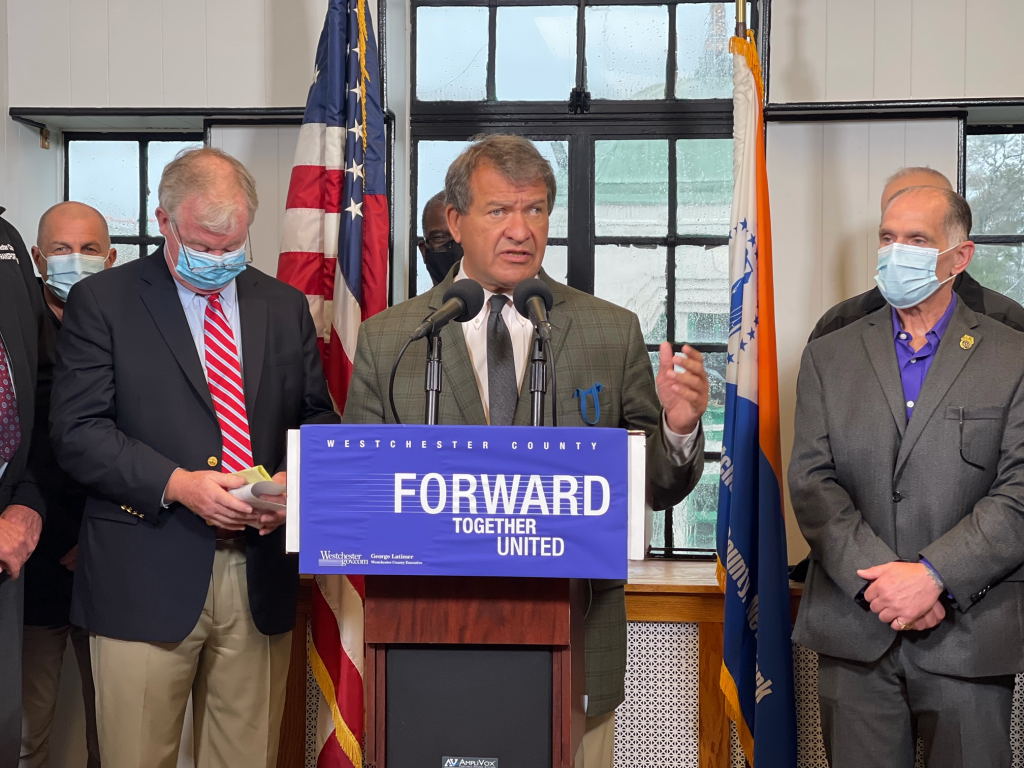
Smaller Penn Station Improvement Project Envisioned
NEW YORK – In early November New York Gov. Kathy Hochul unveiled a smaller vision compared to her predecessor for a new Penn Station, but one that is also designed to help revitalize the surrounding neighborhood.
The new plan reduces 1.4 million sq. ft. the amount of space that is to be developed. The plan also calls for the reconstruction of the existing Penn Station to accelerate, given that 60% of those using the facility are subway and LIRR riders.
The new neighborhood plan comes after several months of collaboration and more than 100 meetings with community stakeholders, government agencies

and elected officials. The plan will also be subject to further public review and is part of a larger public process that remains ongoing, state officials said.
“I’m reimagining the New York City commuter experience; New Yorkers do not deserve what they have been subjected to for decades at Penn Station,” the governor said.
The current Penn Station—the Western Hemisphere’s busiest transit hub—serves more passengers than LaGuardia, John F. Kennedy and Newark Airports. The relocation of Amtrak’s operations to the new Moynihan Train Hall provides the opportunity to overhaul Penn Station, eliminating the bulk of the first subterranean level to open up the main concourse to natural light, improving retail and other user amenities, increasing safety and security, significantly expanding passenger circulation areas, expanding entrances and exits, and making it easier for passengers to navigate within the station as well as connect to their destinations beyond. The reconstruction of the station is expected to cost up to $7 billion, and will take up to five years to complete after construction begins.
In terms of the surrounding development, which will help fund the project, the governor said the new proposal still achieves the necessary revenues while notably scaling down the previous plan. The new plan includes recommendations from the Community Advisory Committee Working Group (CACWG), which worked in consultation with Empire State Development, the Metropolitan Transportation Authority, Amtrak and NJ Transit. The CACWG will continue to inform the plan through its build-out. The governor is directing the MTA to actively engage community stakeholders, transit, sustainability and planning experts as well as users of Penn Station from across the region.
Reimagining the station is intended to create equitable transit access and spur economic development. This will be particularly beneficial for future riders of the proposed Metro-North stations in the East Bronx (Co-op City, Morris Park, Parkchester, and Hunts Point), for whom travel times to and from Midtown will be reduced by up to 50 minutes with the Penn Access.
Key features of the new proposal include:
New, World-Class Train Facility. Creates a single level, double-height train hall that doubles passenger circulation space on the new public level from approximately 123,000 square feet to approximately 250,000 square feet and eliminates the congested, cramped and crowded passageways in existing Penn Station.
The plan also includes a 450-foot-long sunlit train hall that is the size of Moynihan’s and Grand Central’s halls combined; simplifies navigation; creates clear sight lines to exits and entrances and adds 18 more escalators or stairs and 11 more elevators to platforms.
Reduced Density. Shaves off 1.4 million square feet of development from the previous plan and decreases heights for proposed buildings. The plan also provides new design controls to protect views of the Empire State Building along 33rd Street.
Public Realm and Social Services. Adds eight acres of public space, including a 30,000-square foot plaza comparable in size to Rockefeller Plaza and mandates public space set-asides on each building site.
Creates a Public Realm Task Force. Comprised of community leaders and stakeholders, the group will develop a plan of prioritized public realm improvements, to be funded by a Public Realm Fund, with initial revenue from redevelopment being dedicated to this fund. It also requires community facility spaces that will prioritize much-needed social services for the neighborhood, with a particular focus on New Yorkers experiencing homelessness and creates underground loading/unloading for Madison Square Garden, taking trucks off the street.
Affordable Housing. Allows up to 1,800 residential units, of which 540 would be permanently affordable and mandates one building as residential, which will include 162 permanently affordable units—more than the entire number of residences that would be displaced if the southern expansion of Penn Station occurs.
Public Transit Access and Shared Streets. Expands new underground corridors to the Sixth Avenue IND line, allowing users of the 34th Street Herald Square Station (B, F, M, N, R, W lines) seamless access to Penn Station and nearly doubles the existing entrances to Penn Station from 12 to 20, and requires developers to add additional subway entrances and exits directly to and from buildings, ultimately reducing density and congestion at over-crowded entrances. In addition, the plan widens sidewalks throughout the neighborhood and recommends that 31st, 32nd and 33rd streets become shared streets that prioritize pedestrians. It also adds protected bike lanes and greatly expands bike parking while reducing vehicular parking.
Pedestrian-Friendly Streetscape. The proposal limits the size of new building commercial lobbies and requires that 40% of every building frontage is an “active use” such as retail and community facilities.
Janno Lieber, MTA acting chair and CEO, said of the new proposal, “Penn Station is the busiest transportation facility in the city, with six subway lines, countless bus routes, and soon four railroads, and we’ve been waiting generations for Penn Station to be upgraded.”
Assemblymember Amy Paulin, chair of the New York State Assembly Committee on Corporations, Authorities, and Commissions, said, “Public transportation is essential to the lives and livelihoods of our region’s residents and economy. A renovation of Penn Station would give a significant quality-of-life benefit to the over 500,000 commuters to New York City including Metro-North riders when Penn Station Access is completed. It would also support reverse commuters, benefitting New York’s job market and economy. The way to build up and maintain ridership is to transform major hubs like Penn Station to serve customer needs beyond catching the train.”
Financial Management
Flight to Quality in Class A Office Market Prioritizes Technology, Amenities
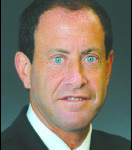
Typically, commercial office buildings are separated into three classes: A, B and C, based on a combination of factors that indicate the building’s competitive ability in the tenant market. Until recently, owners of these buildings generally did not take a particularly active hand in the buildout of individual tenant spaces, essentially offering MEP infrastructure and retail spaces on the ground floor while occupiers received a space to build their individual workplaces.
However, in recent years, the emergence of Class A+ or trophy-class buildings is changing the way owners and tenants envision the
commercial leasing dynamic. It’s impacting the projects that contractors are delivering, from new ground-up projects to commercial fit-out opportunities.
The appeal for owners in delivering Class A+ spaces is that they can maximize the price per square footage of their buildings, while also seeing ROI on cost efficiencies gained through smart, Internet of Things technology and carbon reduction. For tenants, there is increasing appeal in flex offices, flexible leasing, better connectivity and cybersecurity, lifestyle amenities and improved energy efficiency, as well as the cobranding opportunities that being in a trophy building can bring. However, amid the pandemic’s office downturn, the power dynamic in the office market has shifted to tenants, which is also driving this issue.
For construction firms looking to win commercial work in 2022 and beyond it means understanding that connectivity in projects is paramount, as is the ability to deliver high-grade technological infrastructure and sustainable building practices. Additionally, more buildings are incorporating big data into building strategies, starting from the design process. That means construction firms must collaborate with firms such as Willow to capture every quantifiable aspect of a building project. Showing technological proficiency can be a differentiator in winning work.
Similarly, leveraging your firm’s diversified verticals can be an asset, as the blending of live-work-play means that many of these projects are incorporating more ambitious retail, dining, hospitality and entertainment components. Here are some things to consider when bidding on new, forward-thinking commercial office projects:
Be Collaborative
Commercial buildings are increasingly an exercise in branding, and distinctive elements are becoming the norm—such as the observation deck at Hudson Yards or the rooftop experience at One Vanderbilt. These aspects that offer tenants, visitors and skyline viewers a wow factor can also bring major construction and engineering challenges. Construction firms competing for these projects must prove they have the experience and the collaborative diplomacy to navigate designs that may be near-and-dear to an owner or designer’s heart. Additionally, distinctive designs for the top of the building can account for upward of five percent of the construction budget. In a word, these are a major investment.
Show Diversification
Elite amenities are a significant factor in the competitive environment for attracting tenants to trophy buildings—especially as more owners are bringing more of a hospitality approach to office “amenitization.” Owners increasingly want offices to feel like luxury hotels and this involves diversified aspects of buildings as they incorporate more dining, gyms, lounges, conference centers, hotels, entertainment venues and arts and cultural attractions into business as usual. Showing that you have the project personnel, from project executives to project managers, with experience on a wide range of asset types can be a major bonus for a construction company.
Similarly, with the rise of flex working brands like WeWork and Industrious, many owners are delivering their own flex brands (such as Tishman Speyer’s Studio). More owners are also building turnkey spaces—i.e. offices that are move-in ready—with significant footprints. This is a value-add opportunity for ground-up contractors, and it offers new kinds of fit-out opportunities for specialty contractors.
This is an evolution of the open office or team-based office that started to dominate the pre-pandemic market. Now contractors need to deliver new kinds of spaces designed to minimize frictions—from move-in through the life of multiple leases, meaning the project delivery needs to be built to ambitious specifications for the long term.
Incorporate Technology
A big part of the new frictionless office is technology. MEP engineers and the construction firms that collaborate with them have a harder job than ever in delivering the physical infrastructure to support fiber optics, extensive wireless connectivity and a range of sensors, monitors and other hardware pieces of the vast IoT networks that go into smart buildings. Ensuring your construction firm is well-versed in the technologies owners and tenants want is crucial.
In the same vein, showing digital fluency and innovation in the ways your own firm incorporates construction technology goes a long way in instilling confidence that your project will itself be smart, sustainable, on-time and on-budget. From industry standards like BIM, drones and VR to more cutting-edge solutions like digital twins and augmented reality, owners want to see that their contractors are embracing new and more efficient (i.e. more cost effective and safe) ways of working. This is a great way to add further value to work done that could qualify for the Research & Development Tax Credit, available to A/E/C industry companies that design, develop or improve products, processes, methods, techniques, or materials.
What’s more, many of these trophy-class offices work from the ground up with big data, turning the buildings themselves into digital assets. Showing fluency and a collaborative approach to technology really does touch every aspect of how your firm can present itself.
Be Sustainable
Just as sustainability is a cornerstone of the modern luxury resident or hospitality experience, trophy-class buildings tout their own ecological stewardship to win tenants and accolades—especially now with Local Law 97. This starts with the construction project. Showing a robust sustainability record and commitment to sustainable sourcing, waste, ground water and energy usage, as well as ensuring everything is always up to code and will maintain high performance and safety for the life of the building, are all major decision points in bidding on Class A+ work, whether it’s the ground up project or later fit-out work. Additionally, with air quality becoming a long-term post-pandemic concern, high-performing HVAC technology that is also sustainable is a priority for new buildings. Understanding new developments, such as variable refrigerant flow or geothermal energy, can be bonuses in winning bids.
Realistic Cost Planning
Because of the complex nature of these projects and the bar-raising nature of their finished products, their high emphasis on design and quality can mean unexpected costs and delays, whether it’s unforeseen engineering or delivery delays or supply chain issues. Furthermore, there is less precedent for these kinds of projects than there is for Class A, B or C buildings, so effective cost planning and measurement can be a challenge. Your team should be thorough and realistic in estimating costs from the outset, both in terms of setting expectations for your potential clients and for determining if the risks make sense for your firm in the first place.
As technology advances and sustainability becomes more of a driving factor in commercial real estate, trophy-class buildings will continue to set standards for top-tier design, construction and engineering processes. It is important to show how your firm is at the leading edge in this class of project—as well as pick the project where your firm can really shine and win bidding success on future projects.
About the author: Phillip Ross, CPA, CGMA is an Accounting and Audit Partner and Chair of the Construction Industry Group at Anchin, Block & Anchin, LLP. For more construction industry thought leadership and content, log on to www.anchin.com.
Construction NEWS
PHOTO GALLERY
11th Annual CAI Seminar For P.E.s Draws Dozens for CPE Credits
TARRYTOWN, NY—The eleventh annual program entitled “Construction Solutions for Engineering Designs” for professional engineers was held on Oct. 6 at Abigail Kirsch/Tappan Hill Manson here. The program earned the enrolled P.E.s a total of six professional continuing-education credits, according to Mark Fante, chairman of the Construction Advancement Institute of Westchester & The Mid-Hudson Region, Inc., which presented the program.
Attendees earned the professional development/HSW hours from the American Institute of Architects (AIA), and those health safety welfare credits are also recognized by the New York State Department of Education for P.E.s, added Mr. Fante, who is vice president of Darante Construction Inc.
The guest experts presenting at the program covered a range of topics, including concrete, groundwater, foundations, legal matters and fireproofing. They were:
Modern Concrete Repair Technology – William Lyons III, FACI, who is National Business Development Manager, North East of The Euclid Chemical Company;
Reducing Engineering Liabilities – Thomas H. Welby, Esq., P.E., of the law firm Welby, Brady & Greenblatt, LLP;
3-D modeling and Steel Design – Michael J. Squarzini, P.E., who is Co-CEO of the engineering firm Thornton Tomasetti;
Subsurface Exploration for Foundation Design & Construction – Alfred H. Brand, P.E., D.GE, who is Technical Specialist at Mueser Rutledge Consulting Engineers;
Construction Dewatering – Matthew Cichetti, P.E., Principal, Cichetti Engineering/Earth Construction Services; and,
Building Compartmentalization Utilizing Fire-Resistive Materials – Jonathan B. Wohl, principal of Wohl Diversified Services.
A new program is now being planned for mid-2022. For more information and registration, contact CAI Program Manager Laurel Brunelle at (914) 631-1033 or laurel@bcanys.org.
LOW BIDS
NYS DOT Awards 10 Contracts For Work in Downstate and H.V.
ALBANY — The New York State Department of Transportation has announced the selection of 10 apparent low bidders for work in the New York City and Hudson Valley regions.
Yonkers Contracting Company, Inc., of Yonkers, NY was the lowest of four bidders at $17,511,000. for Interstate 84 paving between the Bowden Road overpass to Connecticut state line in Dutchess and Putnam counties.
Argenio Brothers Inc. of New Windsor, NY was the lowest of five bidders at $3,877,877.00 for paving on Route 218, West Point Highway, and Old State Road in the Village of Highland Falls and Town of Highlands in Orange County.
DeFoe Corp. of Mount Vernon, NY was the lowest of six bidders at $22,782,601.90 for bridge replacement of Hospital Road over NY Route 27 in the Town of Brookhaven in Suffolk County.
Tully Construction Company Inc. of Flushing, NY was the lowest of five bidders at $43,631,805.00 for pavement resurfacing on I-495 in the towns of Brookhaven & Islip in Suffolk County.
Tully Construction Company Inc. of Flushing, NY was the lowest of five bidders at $41,085,911.50 for 11.36 miles pavement milling and resurfacing, I-495 in the towns of Huntington, Smithtown and Islip in Suffolk County.
Callanan Industries Inc., of Albany, NY was the lowest of three bidders at $7,846,906.04 for paving project: Routes 32, 199 and 209 in the Town of Ulster in Ulster County.
Perfetto Contracting Company Inc. of Brooklyn, NY was the lowest of 17 bidders at $29,512,900. for ramp reconfiguration at the I-95/Pelham Parkway Interchange and construct new exit ramp from Hutchinson River Parkway to Bartow Avenue in Bronx County.
DiFazio Industries LLC of Staten Island, NY was the lowest of 14 bidders at $26,864,770.75 for bridge rehabilitation of Woolley Ave. and Bradley Ave. over the Staten Island Expressway in Staten Island.
Constar Inc. of Central Islip, NY was the lowest of four bidders at $3,647,100.00 for bridge cleaning contract NYSDOT Region 10 in Nassau and Suffolk counties.
E.J. Electric Installation Co. of Long Island City, NY was the lower of two bids at $7,095,000.00 for ITS Field Network System Maintenance and Support throughout New York City in Bronx, Kings, New York, Queens and Richmond counties.

